Strategic Adoption of Circular Economy Practices at Deloitte Company
VerifiedAdded on 2023/06/11
|10
|2160
|243
Report
AI Summary
This report advocates for Deloitte Consultant Company to embrace circular economy practices, highlighting its potential to enhance productivity, reduce waste, and drive sustainable business growth. It explains the principles behind circular economy, tracing its origins through schools of thought like Cradle to Cradle, Natural Capitalism, and Performance Economy. The report details numerous benefits, including financial savings, increased material value, new market development, customer loyalty, and risk reduction. Case studies of Google, Coca-Cola, and DLL Group illustrate successful implementation of circular economy principles. Furthermore, the report recommends how Australian companies, including Deloitte, can adopt circular economy models, emphasizing the importance of involving the right people and fostering a company-wide commitment to sustainability. The conclusion underscores the significance of circular economy for businesses, emphasizing its role in enhancing productivity and reducing product wastage, positioning it as a crucial strategy for achieving better sustainability.
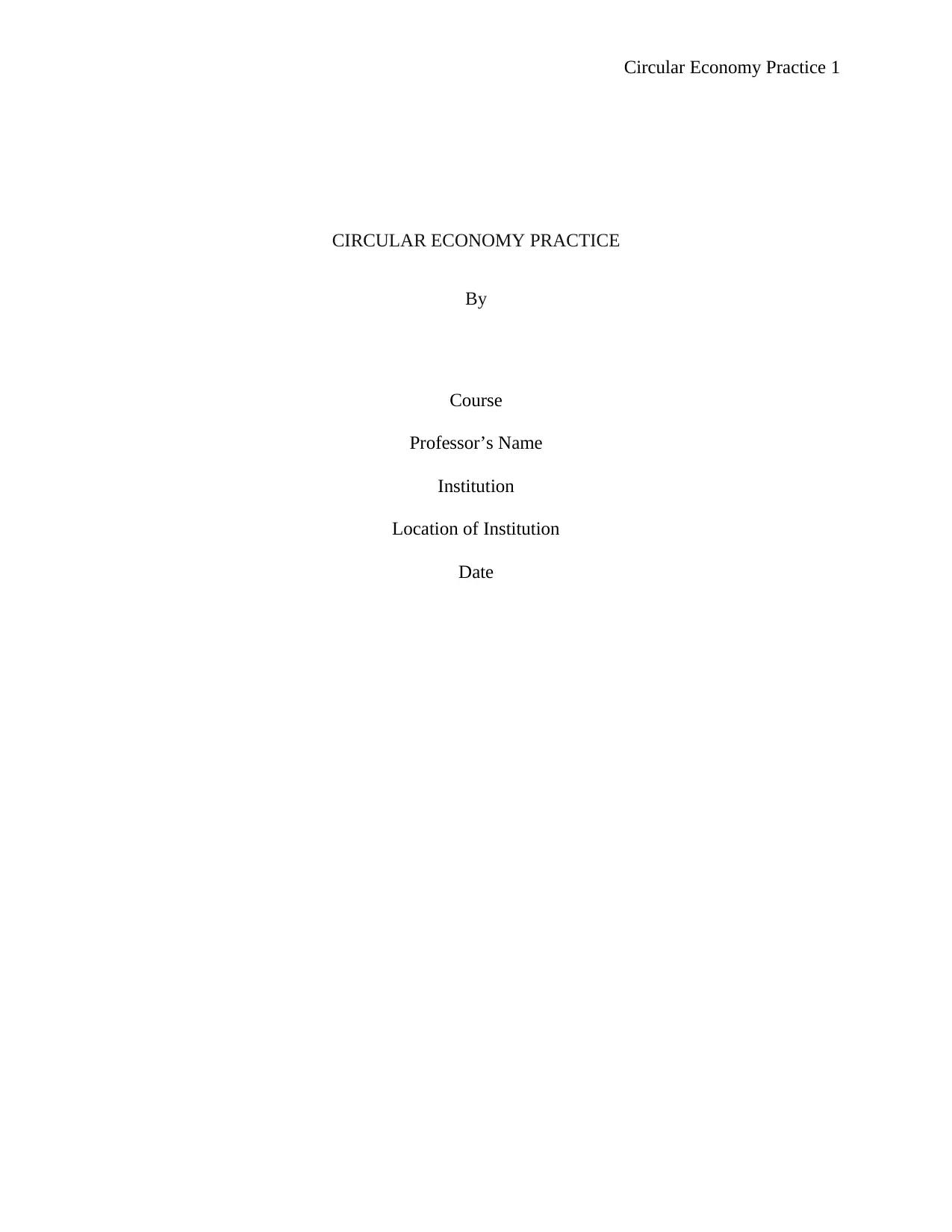
Circular Economy Practice 1
CIRCULAR ECONOMY PRACTICE
By
Course
Professor’s Name
Institution
Location of Institution
Date
CIRCULAR ECONOMY PRACTICE
By
Course
Professor’s Name
Institution
Location of Institution
Date
Paraphrase This Document
Need a fresh take? Get an instant paraphrase of this document with our AI Paraphraser
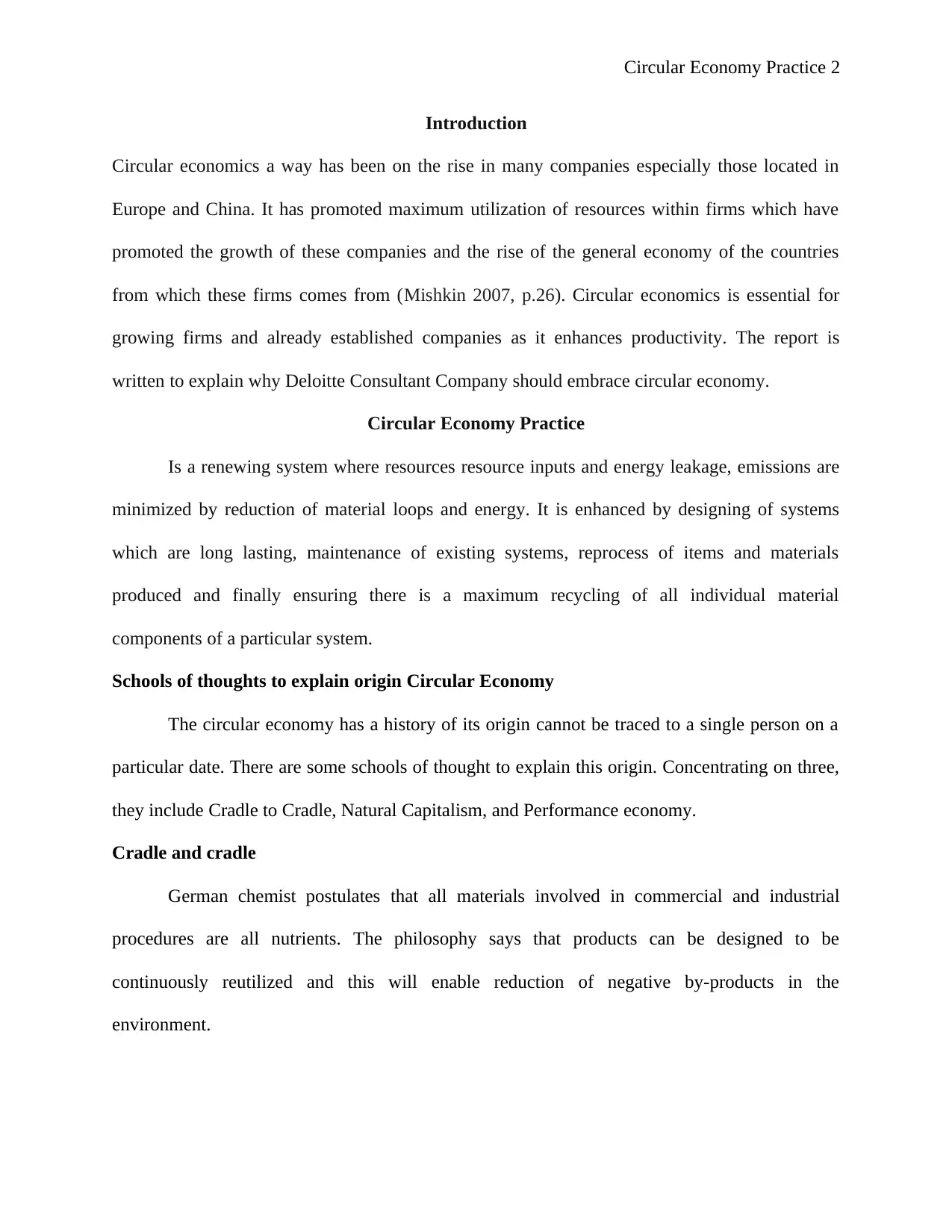
Circular Economy Practice 2
Introduction
Circular economics a way has been on the rise in many companies especially those located in
Europe and China. It has promoted maximum utilization of resources within firms which have
promoted the growth of these companies and the rise of the general economy of the countries
from which these firms comes from (Mishkin 2007, p.26). Circular economics is essential for
growing firms and already established companies as it enhances productivity. The report is
written to explain why Deloitte Consultant Company should embrace circular economy.
Circular Economy Practice
Is a renewing system where resources resource inputs and energy leakage, emissions are
minimized by reduction of material loops and energy. It is enhanced by designing of systems
which are long lasting, maintenance of existing systems, reprocess of items and materials
produced and finally ensuring there is a maximum recycling of all individual material
components of a particular system.
Schools of thoughts to explain origin Circular Economy
The circular economy has a history of its origin cannot be traced to a single person on a
particular date. There are some schools of thought to explain this origin. Concentrating on three,
they include Cradle to Cradle, Natural Capitalism, and Performance economy.
Cradle and cradle
German chemist postulates that all materials involved in commercial and industrial
procedures are all nutrients. The philosophy says that products can be designed to be
continuously reutilized and this will enable reduction of negative by-products in the
environment.
Introduction
Circular economics a way has been on the rise in many companies especially those located in
Europe and China. It has promoted maximum utilization of resources within firms which have
promoted the growth of these companies and the rise of the general economy of the countries
from which these firms comes from (Mishkin 2007, p.26). Circular economics is essential for
growing firms and already established companies as it enhances productivity. The report is
written to explain why Deloitte Consultant Company should embrace circular economy.
Circular Economy Practice
Is a renewing system where resources resource inputs and energy leakage, emissions are
minimized by reduction of material loops and energy. It is enhanced by designing of systems
which are long lasting, maintenance of existing systems, reprocess of items and materials
produced and finally ensuring there is a maximum recycling of all individual material
components of a particular system.
Schools of thoughts to explain origin Circular Economy
The circular economy has a history of its origin cannot be traced to a single person on a
particular date. There are some schools of thought to explain this origin. Concentrating on three,
they include Cradle to Cradle, Natural Capitalism, and Performance economy.
Cradle and cradle
German chemist postulates that all materials involved in commercial and industrial
procedures are all nutrients. The philosophy says that products can be designed to be
continuously reutilized and this will enable reduction of negative by-products in the
environment.
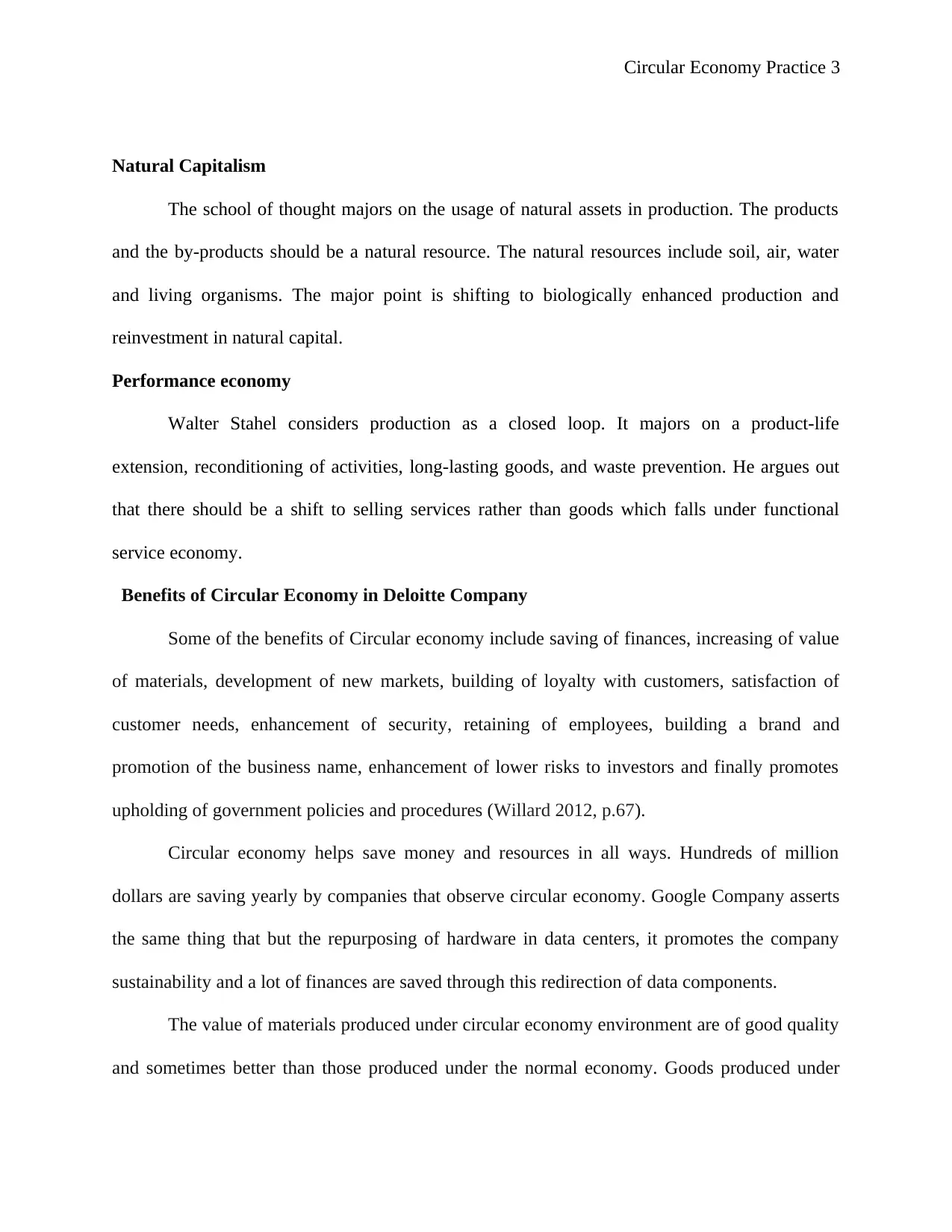
Circular Economy Practice 3
Natural Capitalism
The school of thought majors on the usage of natural assets in production. The products
and the by-products should be a natural resource. The natural resources include soil, air, water
and living organisms. The major point is shifting to biologically enhanced production and
reinvestment in natural capital.
Performance economy
Walter Stahel considers production as a closed loop. It majors on a product-life
extension, reconditioning of activities, long-lasting goods, and waste prevention. He argues out
that there should be a shift to selling services rather than goods which falls under functional
service economy.
Benefits of Circular Economy in Deloitte Company
Some of the benefits of Circular economy include saving of finances, increasing of value
of materials, development of new markets, building of loyalty with customers, satisfaction of
customer needs, enhancement of security, retaining of employees, building a brand and
promotion of the business name, enhancement of lower risks to investors and finally promotes
upholding of government policies and procedures (Willard 2012, p.67).
Circular economy helps save money and resources in all ways. Hundreds of million
dollars are saving yearly by companies that observe circular economy. Google Company asserts
the same thing that but the repurposing of hardware in data centers, it promotes the company
sustainability and a lot of finances are saved through this redirection of data components.
The value of materials produced under circular economy environment are of good quality
and sometimes better than those produced under the normal economy. Goods produced under
Natural Capitalism
The school of thought majors on the usage of natural assets in production. The products
and the by-products should be a natural resource. The natural resources include soil, air, water
and living organisms. The major point is shifting to biologically enhanced production and
reinvestment in natural capital.
Performance economy
Walter Stahel considers production as a closed loop. It majors on a product-life
extension, reconditioning of activities, long-lasting goods, and waste prevention. He argues out
that there should be a shift to selling services rather than goods which falls under functional
service economy.
Benefits of Circular Economy in Deloitte Company
Some of the benefits of Circular economy include saving of finances, increasing of value
of materials, development of new markets, building of loyalty with customers, satisfaction of
customer needs, enhancement of security, retaining of employees, building a brand and
promotion of the business name, enhancement of lower risks to investors and finally promotes
upholding of government policies and procedures (Willard 2012, p.67).
Circular economy helps save money and resources in all ways. Hundreds of million
dollars are saving yearly by companies that observe circular economy. Google Company asserts
the same thing that but the repurposing of hardware in data centers, it promotes the company
sustainability and a lot of finances are saved through this redirection of data components.
The value of materials produced under circular economy environment are of good quality
and sometimes better than those produced under the normal economy. Goods produced under
⊘ This is a preview!⊘
Do you want full access?
Subscribe today to unlock all pages.

Trusted by 1+ million students worldwide
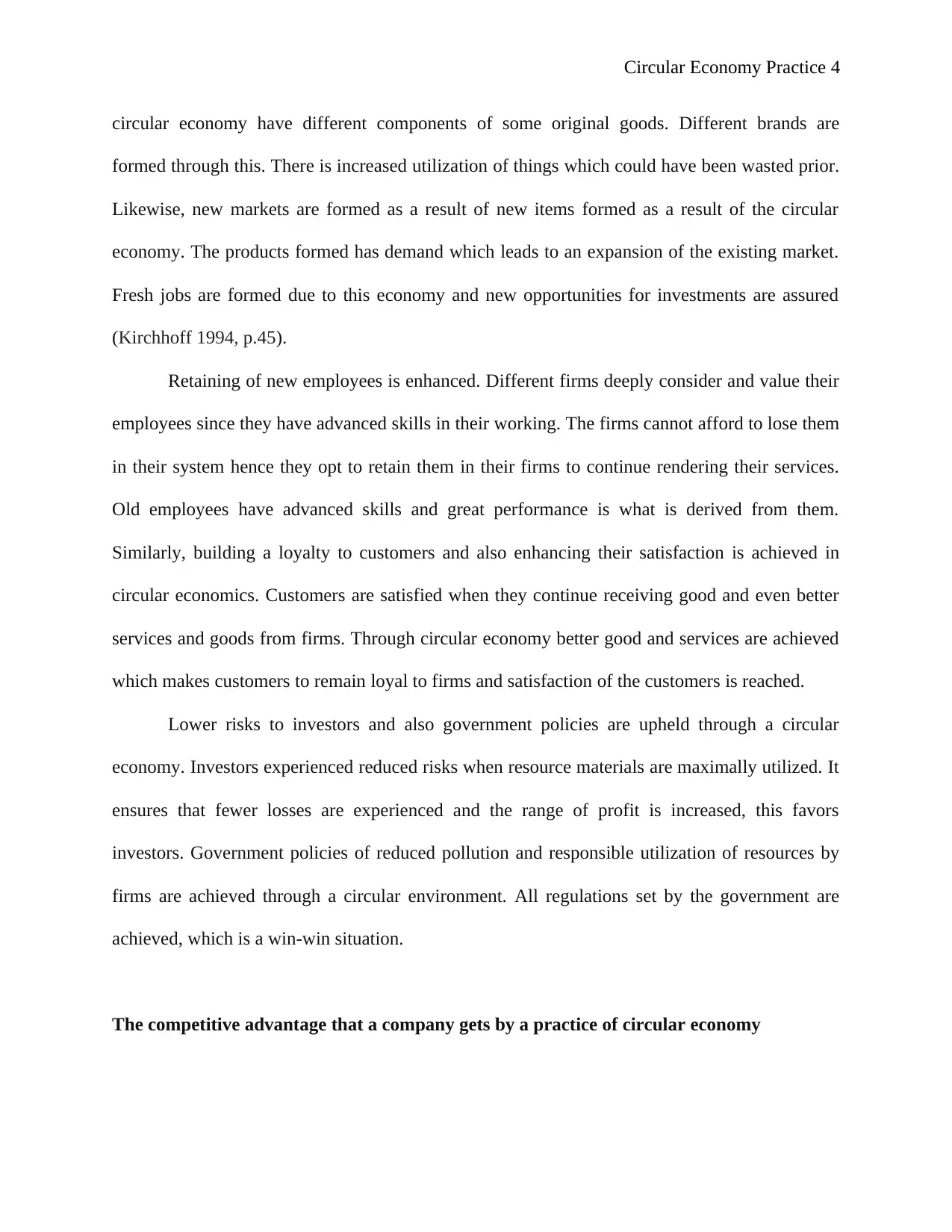
Circular Economy Practice 4
circular economy have different components of some original goods. Different brands are
formed through this. There is increased utilization of things which could have been wasted prior.
Likewise, new markets are formed as a result of new items formed as a result of the circular
economy. The products formed has demand which leads to an expansion of the existing market.
Fresh jobs are formed due to this economy and new opportunities for investments are assured
(Kirchhoff 1994, p.45).
Retaining of new employees is enhanced. Different firms deeply consider and value their
employees since they have advanced skills in their working. The firms cannot afford to lose them
in their system hence they opt to retain them in their firms to continue rendering their services.
Old employees have advanced skills and great performance is what is derived from them.
Similarly, building a loyalty to customers and also enhancing their satisfaction is achieved in
circular economics. Customers are satisfied when they continue receiving good and even better
services and goods from firms. Through circular economy better good and services are achieved
which makes customers to remain loyal to firms and satisfaction of the customers is reached.
Lower risks to investors and also government policies are upheld through a circular
economy. Investors experienced reduced risks when resource materials are maximally utilized. It
ensures that fewer losses are experienced and the range of profit is increased, this favors
investors. Government policies of reduced pollution and responsible utilization of resources by
firms are achieved through a circular environment. All regulations set by the government are
achieved, which is a win-win situation.
The competitive advantage that a company gets by a practice of circular economy
circular economy have different components of some original goods. Different brands are
formed through this. There is increased utilization of things which could have been wasted prior.
Likewise, new markets are formed as a result of new items formed as a result of the circular
economy. The products formed has demand which leads to an expansion of the existing market.
Fresh jobs are formed due to this economy and new opportunities for investments are assured
(Kirchhoff 1994, p.45).
Retaining of new employees is enhanced. Different firms deeply consider and value their
employees since they have advanced skills in their working. The firms cannot afford to lose them
in their system hence they opt to retain them in their firms to continue rendering their services.
Old employees have advanced skills and great performance is what is derived from them.
Similarly, building a loyalty to customers and also enhancing their satisfaction is achieved in
circular economics. Customers are satisfied when they continue receiving good and even better
services and goods from firms. Through circular economy better good and services are achieved
which makes customers to remain loyal to firms and satisfaction of the customers is reached.
Lower risks to investors and also government policies are upheld through a circular
economy. Investors experienced reduced risks when resource materials are maximally utilized. It
ensures that fewer losses are experienced and the range of profit is increased, this favors
investors. Government policies of reduced pollution and responsible utilization of resources by
firms are achieved through a circular environment. All regulations set by the government are
achieved, which is a win-win situation.
The competitive advantage that a company gets by a practice of circular economy
Paraphrase This Document
Need a fresh take? Get an instant paraphrase of this document with our AI Paraphraser
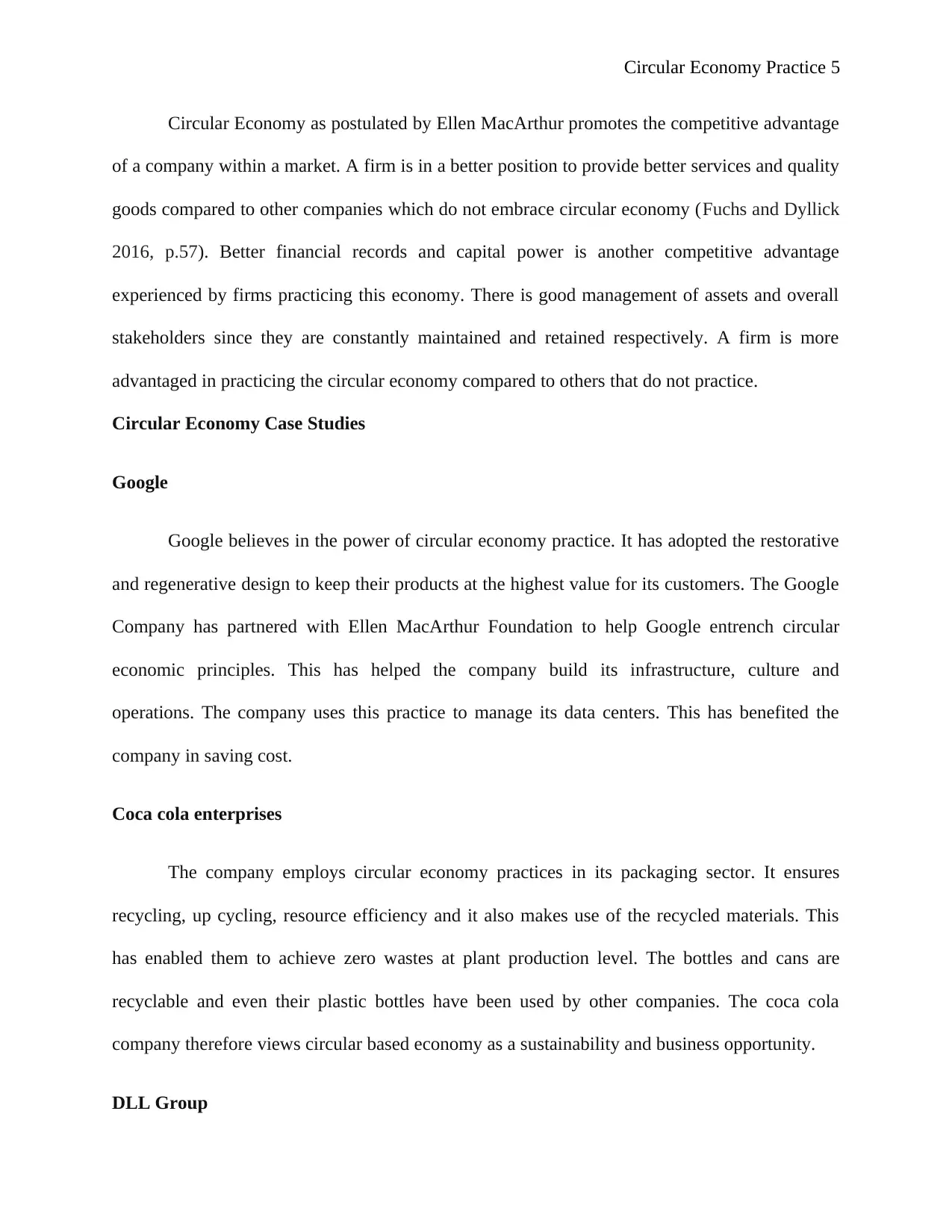
Circular Economy Practice 5
Circular Economy as postulated by Ellen MacArthur promotes the competitive advantage
of a company within a market. A firm is in a better position to provide better services and quality
goods compared to other companies which do not embrace circular economy (Fuchs and Dyllick
2016, p.57). Better financial records and capital power is another competitive advantage
experienced by firms practicing this economy. There is good management of assets and overall
stakeholders since they are constantly maintained and retained respectively. A firm is more
advantaged in practicing the circular economy compared to others that do not practice.
Circular Economy Case Studies
Google
Google believes in the power of circular economy practice. It has adopted the restorative
and regenerative design to keep their products at the highest value for its customers. The Google
Company has partnered with Ellen MacArthur Foundation to help Google entrench circular
economic principles. This has helped the company build its infrastructure, culture and
operations. The company uses this practice to manage its data centers. This has benefited the
company in saving cost.
Coca cola enterprises
The company employs circular economy practices in its packaging sector. It ensures
recycling, up cycling, resource efficiency and it also makes use of the recycled materials. This
has enabled them to achieve zero wastes at plant production level. The bottles and cans are
recyclable and even their plastic bottles have been used by other companies. The coca cola
company therefore views circular based economy as a sustainability and business opportunity.
DLL Group
Circular Economy as postulated by Ellen MacArthur promotes the competitive advantage
of a company within a market. A firm is in a better position to provide better services and quality
goods compared to other companies which do not embrace circular economy (Fuchs and Dyllick
2016, p.57). Better financial records and capital power is another competitive advantage
experienced by firms practicing this economy. There is good management of assets and overall
stakeholders since they are constantly maintained and retained respectively. A firm is more
advantaged in practicing the circular economy compared to others that do not practice.
Circular Economy Case Studies
Google believes in the power of circular economy practice. It has adopted the restorative
and regenerative design to keep their products at the highest value for its customers. The Google
Company has partnered with Ellen MacArthur Foundation to help Google entrench circular
economic principles. This has helped the company build its infrastructure, culture and
operations. The company uses this practice to manage its data centers. This has benefited the
company in saving cost.
Coca cola enterprises
The company employs circular economy practices in its packaging sector. It ensures
recycling, up cycling, resource efficiency and it also makes use of the recycled materials. This
has enabled them to achieve zero wastes at plant production level. The bottles and cans are
recyclable and even their plastic bottles have been used by other companies. The coca cola
company therefore views circular based economy as a sustainability and business opportunity.
DLL Group
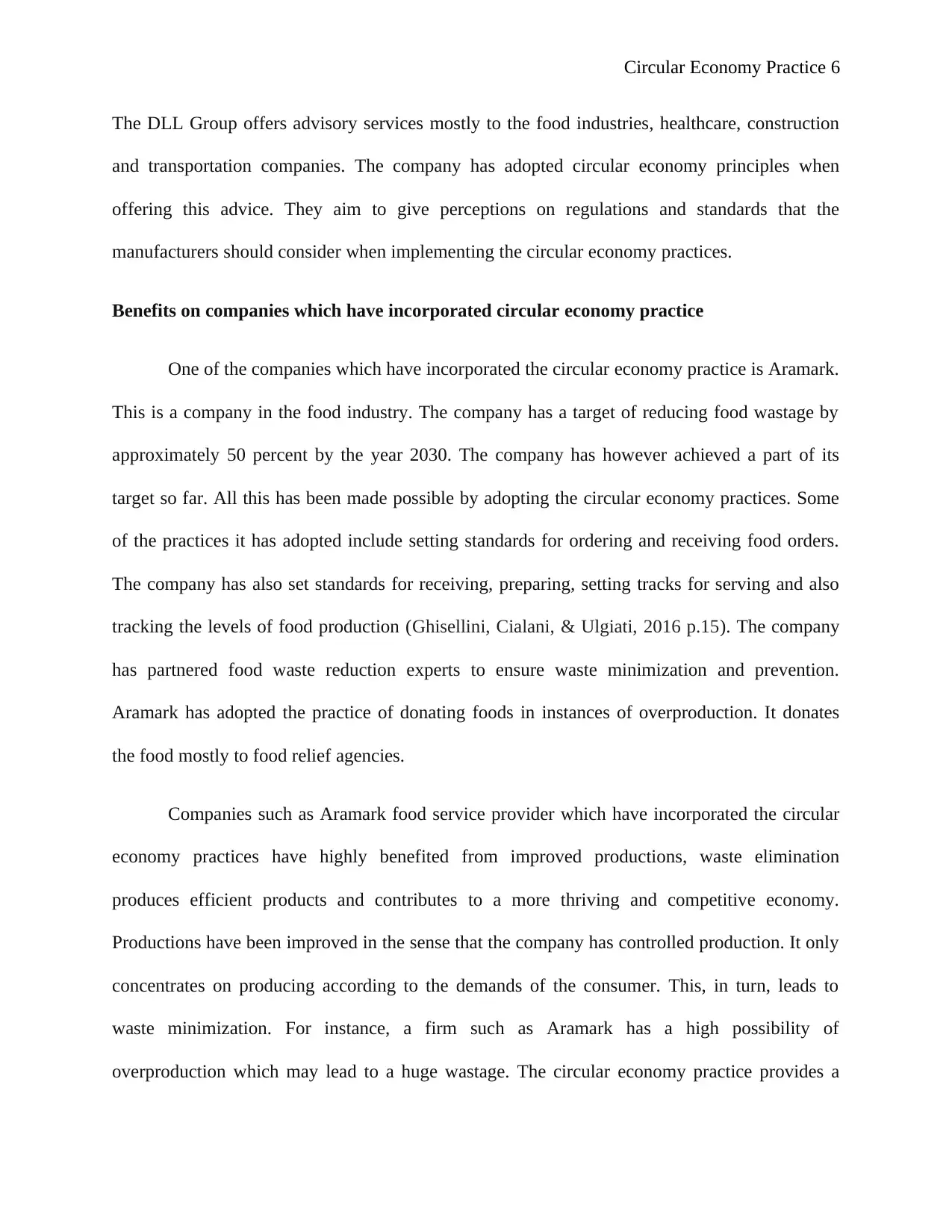
Circular Economy Practice 6
The DLL Group offers advisory services mostly to the food industries, healthcare, construction
and transportation companies. The company has adopted circular economy principles when
offering this advice. They aim to give perceptions on regulations and standards that the
manufacturers should consider when implementing the circular economy practices.
Benefits on companies which have incorporated circular economy practice
One of the companies which have incorporated the circular economy practice is Aramark.
This is a company in the food industry. The company has a target of reducing food wastage by
approximately 50 percent by the year 2030. The company has however achieved a part of its
target so far. All this has been made possible by adopting the circular economy practices. Some
of the practices it has adopted include setting standards for ordering and receiving food orders.
The company has also set standards for receiving, preparing, setting tracks for serving and also
tracking the levels of food production (Ghisellini, Cialani, & Ulgiati, 2016 p.15). The company
has partnered food waste reduction experts to ensure waste minimization and prevention.
Aramark has adopted the practice of donating foods in instances of overproduction. It donates
the food mostly to food relief agencies.
Companies such as Aramark food service provider which have incorporated the circular
economy practices have highly benefited from improved productions, waste elimination
produces efficient products and contributes to a more thriving and competitive economy.
Productions have been improved in the sense that the company has controlled production. It only
concentrates on producing according to the demands of the consumer. This, in turn, leads to
waste minimization. For instance, a firm such as Aramark has a high possibility of
overproduction which may lead to a huge wastage. The circular economy practice provides a
The DLL Group offers advisory services mostly to the food industries, healthcare, construction
and transportation companies. The company has adopted circular economy principles when
offering this advice. They aim to give perceptions on regulations and standards that the
manufacturers should consider when implementing the circular economy practices.
Benefits on companies which have incorporated circular economy practice
One of the companies which have incorporated the circular economy practice is Aramark.
This is a company in the food industry. The company has a target of reducing food wastage by
approximately 50 percent by the year 2030. The company has however achieved a part of its
target so far. All this has been made possible by adopting the circular economy practices. Some
of the practices it has adopted include setting standards for ordering and receiving food orders.
The company has also set standards for receiving, preparing, setting tracks for serving and also
tracking the levels of food production (Ghisellini, Cialani, & Ulgiati, 2016 p.15). The company
has partnered food waste reduction experts to ensure waste minimization and prevention.
Aramark has adopted the practice of donating foods in instances of overproduction. It donates
the food mostly to food relief agencies.
Companies such as Aramark food service provider which have incorporated the circular
economy practices have highly benefited from improved productions, waste elimination
produces efficient products and contributes to a more thriving and competitive economy.
Productions have been improved in the sense that the company has controlled production. It only
concentrates on producing according to the demands of the consumer. This, in turn, leads to
waste minimization. For instance, a firm such as Aramark has a high possibility of
overproduction which may lead to a huge wastage. The circular economy practice provides a
⊘ This is a preview!⊘
Do you want full access?
Subscribe today to unlock all pages.

Trusted by 1+ million students worldwide
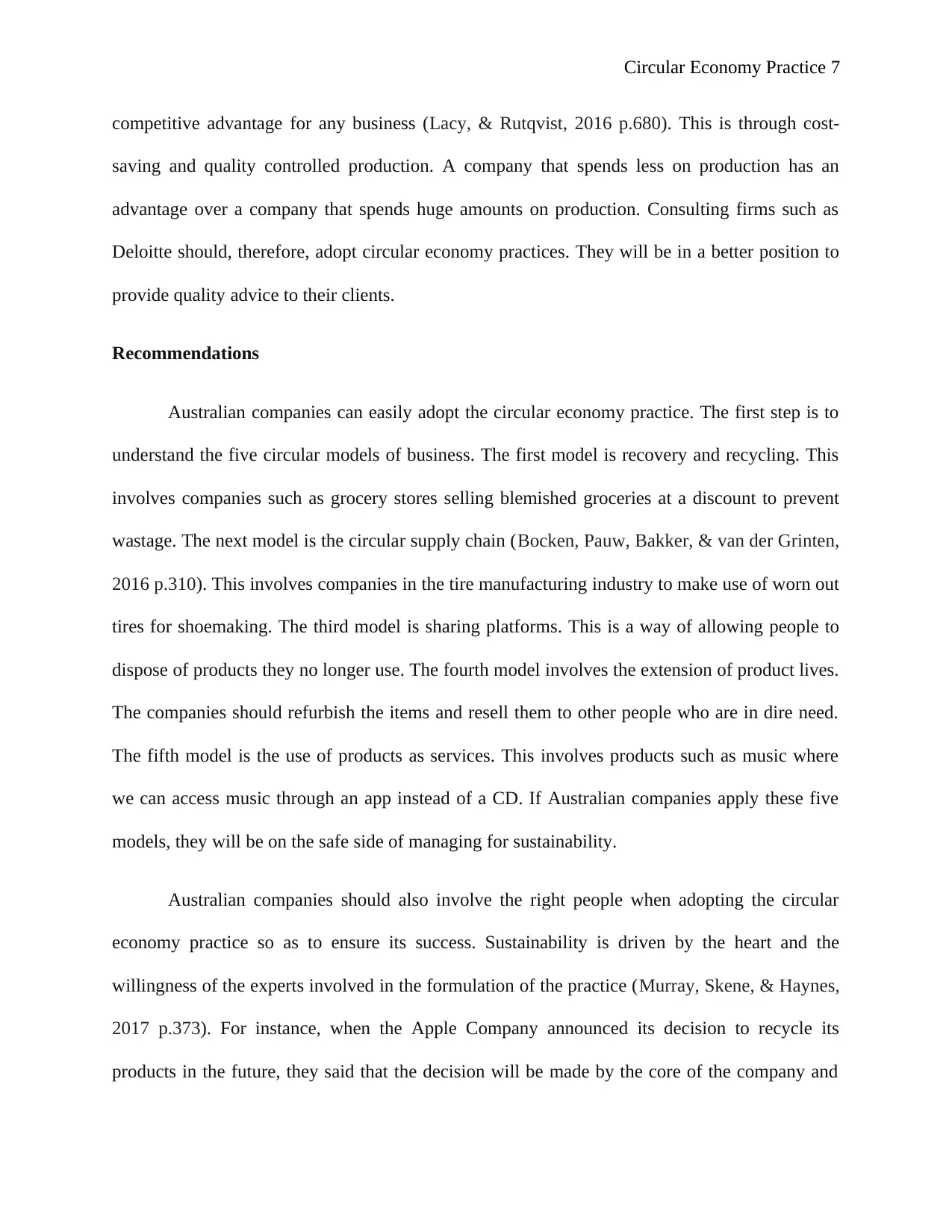
Circular Economy Practice 7
competitive advantage for any business (Lacy, & Rutqvist, 2016 p.680). This is through cost-
saving and quality controlled production. A company that spends less on production has an
advantage over a company that spends huge amounts on production. Consulting firms such as
Deloitte should, therefore, adopt circular economy practices. They will be in a better position to
provide quality advice to their clients.
Recommendations
Australian companies can easily adopt the circular economy practice. The first step is to
understand the five circular models of business. The first model is recovery and recycling. This
involves companies such as grocery stores selling blemished groceries at a discount to prevent
wastage. The next model is the circular supply chain (Bocken, Pauw, Bakker, & van der Grinten,
2016 p.310). This involves companies in the tire manufacturing industry to make use of worn out
tires for shoemaking. The third model is sharing platforms. This is a way of allowing people to
dispose of products they no longer use. The fourth model involves the extension of product lives.
The companies should refurbish the items and resell them to other people who are in dire need.
The fifth model is the use of products as services. This involves products such as music where
we can access music through an app instead of a CD. If Australian companies apply these five
models, they will be on the safe side of managing for sustainability.
Australian companies should also involve the right people when adopting the circular
economy practice so as to ensure its success. Sustainability is driven by the heart and the
willingness of the experts involved in the formulation of the practice (Murray, Skene, & Haynes,
2017 p.373). For instance, when the Apple Company announced its decision to recycle its
products in the future, they said that the decision will be made by the core of the company and
competitive advantage for any business (Lacy, & Rutqvist, 2016 p.680). This is through cost-
saving and quality controlled production. A company that spends less on production has an
advantage over a company that spends huge amounts on production. Consulting firms such as
Deloitte should, therefore, adopt circular economy practices. They will be in a better position to
provide quality advice to their clients.
Recommendations
Australian companies can easily adopt the circular economy practice. The first step is to
understand the five circular models of business. The first model is recovery and recycling. This
involves companies such as grocery stores selling blemished groceries at a discount to prevent
wastage. The next model is the circular supply chain (Bocken, Pauw, Bakker, & van der Grinten,
2016 p.310). This involves companies in the tire manufacturing industry to make use of worn out
tires for shoemaking. The third model is sharing platforms. This is a way of allowing people to
dispose of products they no longer use. The fourth model involves the extension of product lives.
The companies should refurbish the items and resell them to other people who are in dire need.
The fifth model is the use of products as services. This involves products such as music where
we can access music through an app instead of a CD. If Australian companies apply these five
models, they will be on the safe side of managing for sustainability.
Australian companies should also involve the right people when adopting the circular
economy practice so as to ensure its success. Sustainability is driven by the heart and the
willingness of the experts involved in the formulation of the practice (Murray, Skene, & Haynes,
2017 p.373). For instance, when the Apple Company announced its decision to recycle its
products in the future, they said that the decision will be made by the core of the company and
Paraphrase This Document
Need a fresh take? Get an instant paraphrase of this document with our AI Paraphraser
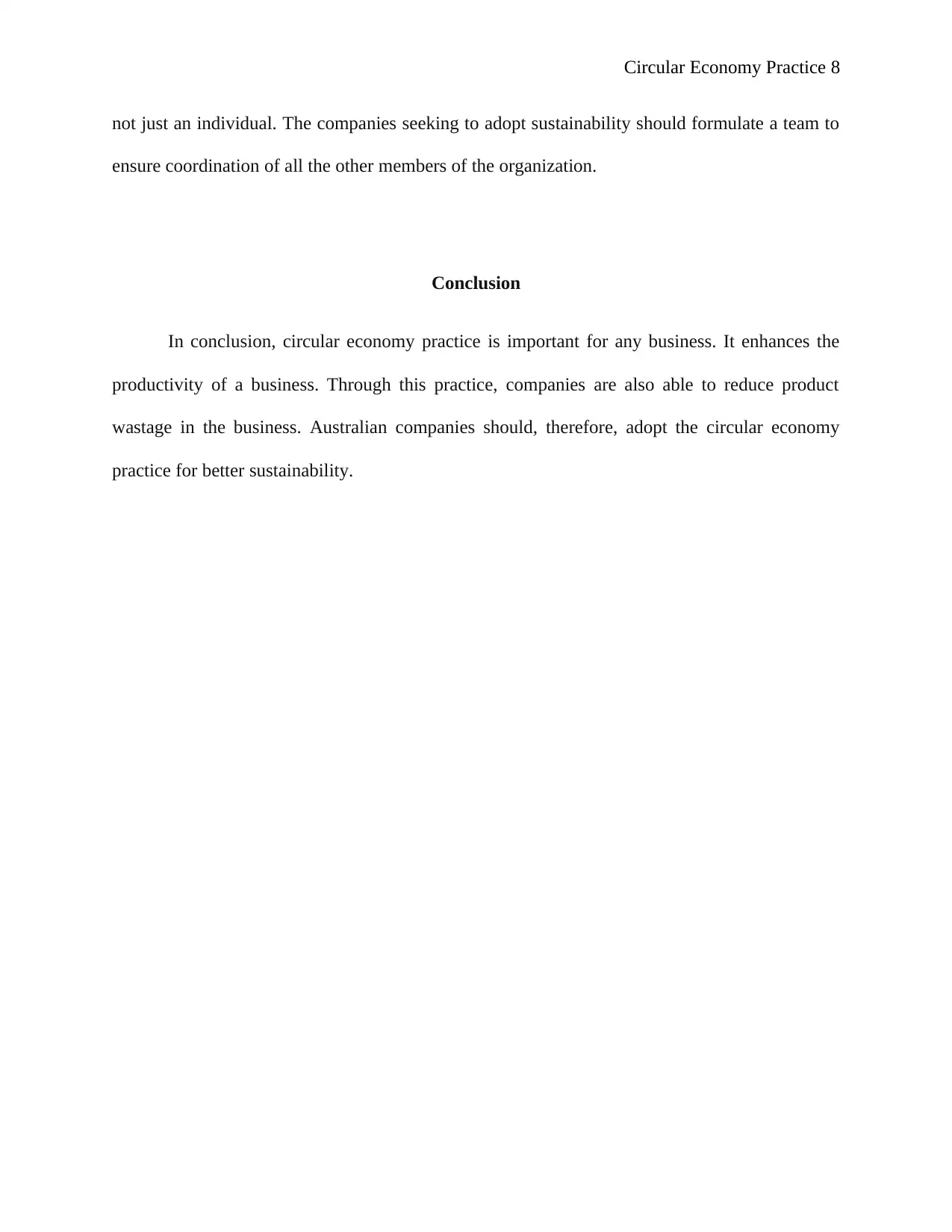
Circular Economy Practice 8
not just an individual. The companies seeking to adopt sustainability should formulate a team to
ensure coordination of all the other members of the organization.
Conclusion
In conclusion, circular economy practice is important for any business. It enhances the
productivity of a business. Through this practice, companies are also able to reduce product
wastage in the business. Australian companies should, therefore, adopt the circular economy
practice for better sustainability.
not just an individual. The companies seeking to adopt sustainability should formulate a team to
ensure coordination of all the other members of the organization.
Conclusion
In conclusion, circular economy practice is important for any business. It enhances the
productivity of a business. Through this practice, companies are also able to reduce product
wastage in the business. Australian companies should, therefore, adopt the circular economy
practice for better sustainability.
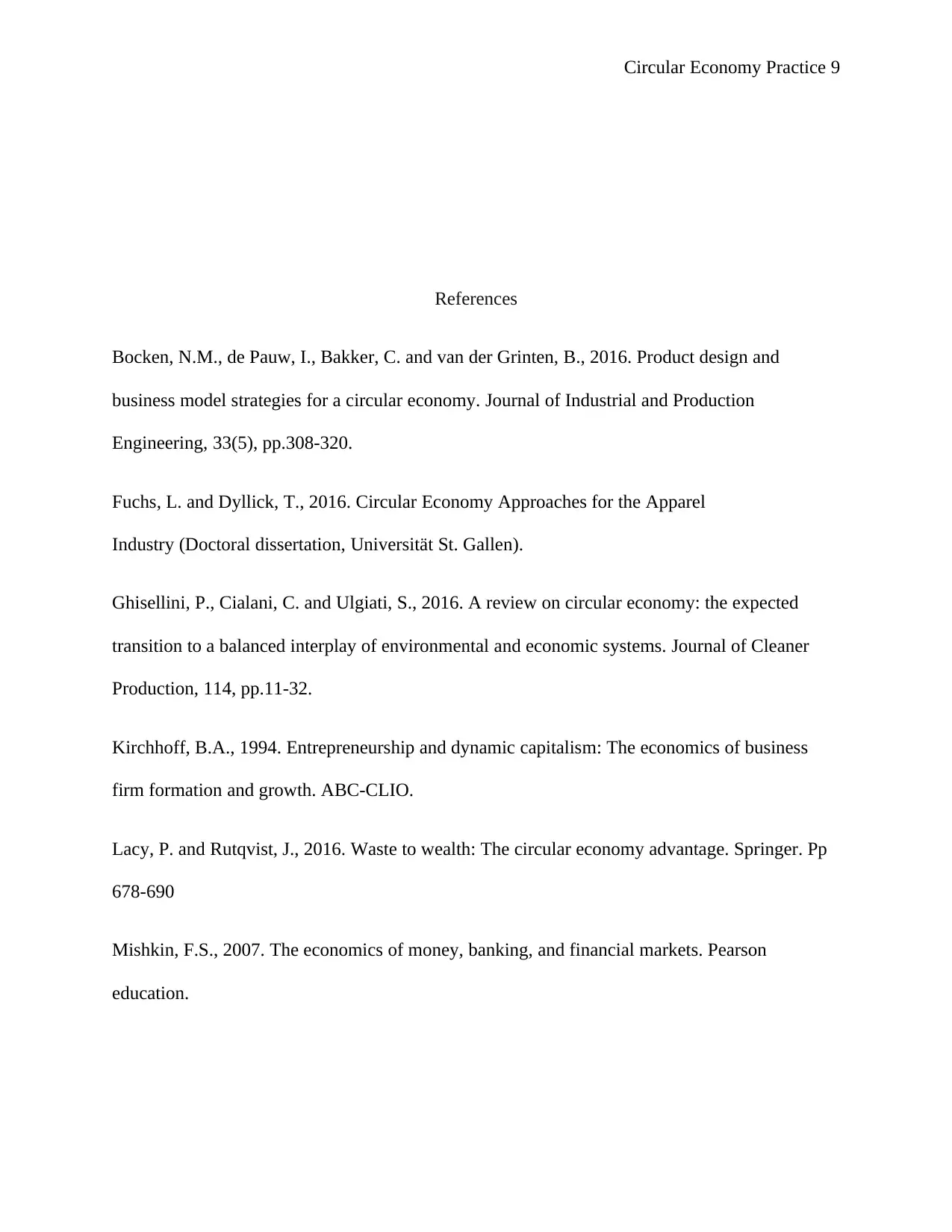
Circular Economy Practice 9
References
Bocken, N.M., de Pauw, I., Bakker, C. and van der Grinten, B., 2016. Product design and
business model strategies for a circular economy. Journal of Industrial and Production
Engineering, 33(5), pp.308-320.
Fuchs, L. and Dyllick, T., 2016. Circular Economy Approaches for the Apparel
Industry (Doctoral dissertation, Universität St. Gallen).
Ghisellini, P., Cialani, C. and Ulgiati, S., 2016. A review on circular economy: the expected
transition to a balanced interplay of environmental and economic systems. Journal of Cleaner
Production, 114, pp.11-32.
Kirchhoff, B.A., 1994. Entrepreneurship and dynamic capitalism: The economics of business
firm formation and growth. ABC-CLIO.
Lacy, P. and Rutqvist, J., 2016. Waste to wealth: The circular economy advantage. Springer. Pp
678-690
Mishkin, F.S., 2007. The economics of money, banking, and financial markets. Pearson
education.
References
Bocken, N.M., de Pauw, I., Bakker, C. and van der Grinten, B., 2016. Product design and
business model strategies for a circular economy. Journal of Industrial and Production
Engineering, 33(5), pp.308-320.
Fuchs, L. and Dyllick, T., 2016. Circular Economy Approaches for the Apparel
Industry (Doctoral dissertation, Universität St. Gallen).
Ghisellini, P., Cialani, C. and Ulgiati, S., 2016. A review on circular economy: the expected
transition to a balanced interplay of environmental and economic systems. Journal of Cleaner
Production, 114, pp.11-32.
Kirchhoff, B.A., 1994. Entrepreneurship and dynamic capitalism: The economics of business
firm formation and growth. ABC-CLIO.
Lacy, P. and Rutqvist, J., 2016. Waste to wealth: The circular economy advantage. Springer. Pp
678-690
Mishkin, F.S., 2007. The economics of money, banking, and financial markets. Pearson
education.
⊘ This is a preview!⊘
Do you want full access?
Subscribe today to unlock all pages.

Trusted by 1+ million students worldwide
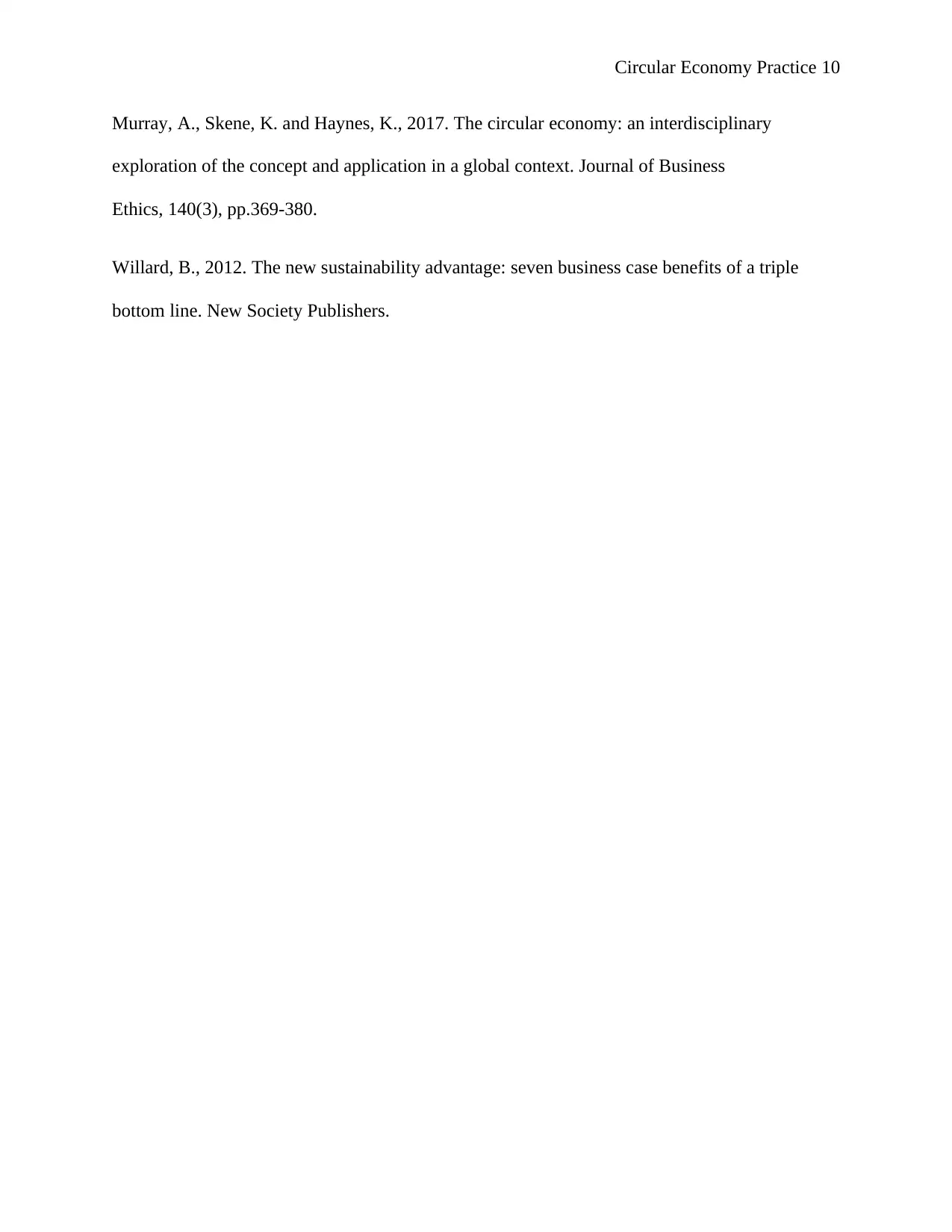
Circular Economy Practice 10
Murray, A., Skene, K. and Haynes, K., 2017. The circular economy: an interdisciplinary
exploration of the concept and application in a global context. Journal of Business
Ethics, 140(3), pp.369-380.
Willard, B., 2012. The new sustainability advantage: seven business case benefits of a triple
bottom line. New Society Publishers.
Murray, A., Skene, K. and Haynes, K., 2017. The circular economy: an interdisciplinary
exploration of the concept and application in a global context. Journal of Business
Ethics, 140(3), pp.369-380.
Willard, B., 2012. The new sustainability advantage: seven business case benefits of a triple
bottom line. New Society Publishers.
1 out of 10
Related Documents
Your All-in-One AI-Powered Toolkit for Academic Success.
+13062052269
info@desklib.com
Available 24*7 on WhatsApp / Email
![[object Object]](/_next/static/media/star-bottom.7253800d.svg)
Unlock your academic potential
Copyright © 2020–2025 A2Z Services. All Rights Reserved. Developed and managed by ZUCOL.





